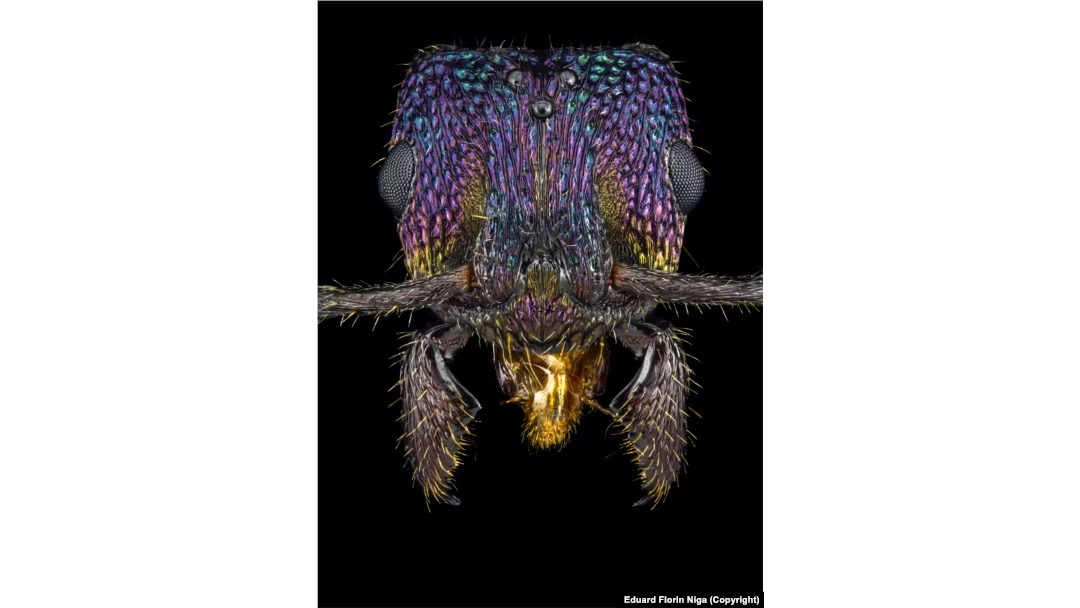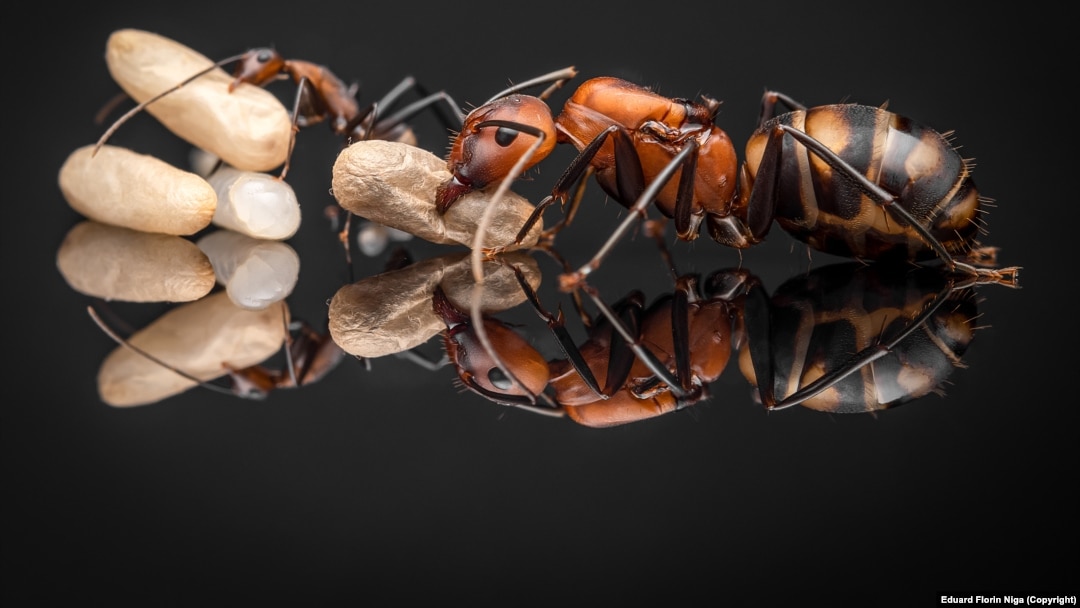As a street cop in northern Romania, Eduard Florin Niga never photographed crime scenes. Instead, between patrols, he'd pepper the forensics team with questions: about their cameras, their depth of field, film sensitivity.
He'd fallen in love with viewing and capturing the tiniest details through the lens of a camera in a handful of classes at the police academy.
"I didn't want that year to finish," Niga says of his police training in the mid-1990s.
Two and a half decades later and with a dizzying array of job experience since immigrating to Britain, he finds "all these dots really, really neatly connected."
Niga's unflinching pictures of ants, beetles, and other insects have won him international praise and a devoted following among entomologists and myrmecologists, as well as nonexperts.
They credit his microscopic images with casting a brilliant new light on the exoskeletal, always bristly, and usually otherworldly appearance of thousands of undersized -- and frequently underappreciated -- species.

A "mug shot" of a green-head or metallic pony ant, known as Rhytidoponera metallica.
A city kid from the Suceava region of northeast Romania, Niga says his fascination with insects started during summer vacations at his grandmother's house in the country.
He got frequent stings chasing bumblebees and hoverflies, which he says he mistook for male bees. He was stung so many times, Niga says, that "now I've got a serious allergy and I've got to be very careful if I want to photograph bees and wasps in the wild."
The metallic-colored cuckoo wasp, a family of around 3,000 species, gets its name because it lays eggs in the nests of unrelated species.
Niga has around 40,000 images of what he guesses are around 4,000 specimens.
"After ants, tiger beetles are my favorite," he says. "I think I may have grown tall, but I haven't grown up."
Tiger beetles have sharp eyes to catch their insect prey. They're also one of the fastest sprinters in the insect world, and essentially go blind at top speeds.
"If you see a tiger beetle's face, that's a face only a mother could love," Niga says. "But they are absolutely beautiful -- the color and the textures and the shapes of the mandibles."
He says it took decades to realize that the tiny bugs that had whirred around him as he swam near his grandmother's country home were tiger beetles. He and other kids tried to catch them, "but they were too fast."
From pinning to shooting and stitching, Niga does most of his work at his home studio in London.
Niga gets most of his specimens through the mail, from entomologists, who study bugs, or myrmecologists, who study ants specifically.
They come from habitats all over the world.
He has called his ant portraits "mug shots" and used to create little posters with the head and the name of the species. "The only thing that's missing is a number," Niga says.
A carpenter ant, from the widespread Camponotus genus, whose coloring makes it popular among ant keepers.
The ant headshots, he says, are of dead specimens.
They have usually been preserved in ethanol. He leaves them for days in a self-made rehydrating chamber before using a microscope to help pin the head and antennae, and sometimes open the jaws, before letting them dry again.
Then it's time for the photo session.
"The photographing process involves stacking hundreds and hundreds of images, because the depth of field is so narrow," Niga says.
This species of army ant, known as Eciton hamatum, is found from Mexico to South America. It is known for building "living bridges" to help scour trees to prey on larvae.
With live ants and other living specimens, "that's a different thing," he says.
He often contacts dealers in live ants, which he calls "a massive, massive business."
He then takes care to handle the ants carefully, often covering them with a transparent cup and a dark cloth "because in the wild they're in the ground, they're in their burrow, and this is where they feel comfortable."
The leaflike ghost mantis, or Phyllocrania paradoxa, that Niga keeps, along with another mantis and lots of ants, as a pet.
There's no stacking or stitching of images with the live animals, he says. The antennae are moving and the subject is not going to sit still for him, and "it's just one single shot."
"I have to make sure the ant is comfortable, and it's not stressed, because you can see that in the images."
Some panicky ants spray formic acid or tuck their abdomen underneath themselves, he says, while others put their antennae and legs in their mouth and try to clean them.
"Or they'll move incredibly fast -- they just go whizzing around and it's practically impossible" to photograph them.
The giraffe weevil, known as Trachelophorus giraffa, is native to Madagascar, with the necks of males outstretching those of females by a factor of two or three.
He says he's careful about his sources for specimens, because he wants to ensure he's not supporting unscrupulous collectors who ignore the environmental effects.
"I care so much about the ants and other insects -- it is such a very important part of the ecosystem and such," Niga says.
He tells of a favorite type of beetle -- "It looks like a wasp"-- that he used to find in a nearby park each summer.
"But I haven't seen one in five years," he says. He has to go a few kilometers farther to find them now. "I don't know what happened. Maybe the council decided to cut some of the shrubs but...it's really upsetting to see that."
After his daughter asked him about their eyes, Niga says he found four species of ant in his yard in London. There are more than 12,000 ant species worldwide.
Niga first took up street photography and had a few images published by National Geographic and Nikon. Then he started photographing urban wildlife, especially in London.
Three or four years ago, at a local park, Niga's young daughter asked him, "Daddy, where are the ant's eyes?"
And his "mug shots" were born: A logical way to answer her question, he says.
A mite near the eye of a buff-tailed bumblebee.
"Only when I got very, very close, with the microscope objective attached, I realized that, 'Oh, cool,' and the texture and the color in the tiny hairs that you, of course, can't [normally] see," he says.
Niga found four different species in his own garden, and someone from Germany put him in touch with other ant keepers.
"And slowly, slowly, I got hooked on insects again," he says. "And then I sold all the equipment for street photography, except for the camera, and I focused on the macro stuff."
Niga says he recently reconfigured his self-fashioned rig in anticipation of a second book. But he's guarded about the project "because I don't want to jinx it."
Immigration to Britain led Niga into a dizzying number of jobs -- electrician, carpenter, auto mechanic, dishwasher, even washing toilets in central London -- before he got his teaching qualifications.
He cites his "immigrant life" and those "laboring" years for transferable skills that have helped him ever since.
He has put some of them to use creating his own macrophotography studio at home.
"I have a rig that I constructed myself, and various lighting systems which don't exist, so you have to make them yourself," Niga says.
Niga's pet praying mantis, perched on his finger.
Now, in addition to being a math and English teacher, Niga is an award-winning photographer and an author.
National Geographic included his ant portraits on its list last month of the "best animal photos of 2021."
A book featuring his photographs, titled Ants: Workers Of The World, was published last year.
And since the pandemic, he's now an online macrophotography instructor.
"I get a kick out of insects, and I've got a wish list of I think it's more than 3,000 insects that I want to purchase and photograph," he says. "So that's never going to stop."


